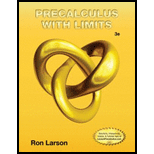
Concept explainers
To use : synthetic division to divide
Answer to Problem 39E
Explanation of Solution
Given information :
Concept Involved:
For long division of polynomials by divisors of the form x - k, there is a shortcut
called synthetic division. The pattern for synthetic division of a cubic polynomial is
summarized below. (The pattern for higher-degree polynomials is similar.)
Synthetic Division (for a Cubic Polynomial): To divide
| In case when we have a polynomial with a missing term, insert placeholders with zero coefficients for missing powers of the variable. Vertical pattern: Add terms in columns Diagonal pattern: Multiply results by k. This algorithm for synthetic division works only for divisors of the form x - k. Remember that |
The Division Algorithm : If
Calculation:
Set up the synthetic division to divide
When you set this up using synthetic division write -8 for the divisor
Bring down the leading coefficient to the bottom row.
Multiply -8 by the value just written on the bottom row. Place this value right beneath the next coefficient in the dividend:
Add the column created and write the sum in the bottom row:
Repeat until done. Multiply -8 by the value just written on the bottom row. Place this value right beneath the next coefficient in the dividend:
Add the column created and write the sum in the bottom row:
Repeat until done. Multiply -8 by the value just written on the bottom row. Place this value right beneath the next coefficient in the dividend
Add the column created and write the sum in the bottom row:
Write out the answer.The numbers in the last row make up your coefficients of the quotient as well as the remainder. The final value on the right is the remainder. Working right to left, the next number is your constant, the next is the coefficient for x , the next is the coefficient for x squared, and so on.
Conclusion:
By dividing the given polynomial
Chapter 2 Solutions
Precalculus with Limits
- Find a unit normal vector to the surface f(x, y, z) = 0 at the point P(-3,4, -32) for the function f(x, y, z) = In -4x -5y- Please write your answer as a vector (a, b, c) with a negative z component, and show your answer accurate to 4 decimal placesarrow_forwardFind the differential of the function f(x, y) = 2x² - 2xy – 5y² at the point (-6, -5) using Ax = 0.3 and Ay = 0.05. dz = Now find Az and compare it to your answer above Ax= Hint: If entering a decimal, round to at least 5 placesarrow_forwardFind the differential of the function f(x, y) = −8x√y at the point (1,3) using Ax = 0.25 and Ay = -0.15. dz Now find Az and compare it to your answer above Az = Hint: If entering a decimal, round to at least 5 placesarrow_forward
- please dont use chat gpt i need to underarrow_forwardChris Lynch plans to invest $200 into a money market account. Find the interest rate that is needed for the money to grow to $1,800 in 12 years if the interest is compounded quarterly. The rate is %. (Round to the nearest percent.)arrow_forwardFind the interest earned on $10,000 invested for 6 years at 6% interest compounded as follows. a. Annually b. Semiannually (twice a year) c. Quarterly d. Monthly e. Continuouslyarrow_forward
- 6.9x y= 100-x a. Find the cost of removing each percent of pollutants: 50%; 70%; 80%; 90%; 95%; 98%; 99%. 50% y = 70% y = 80% y = 90% YF 95% y = 98% y= 99% V =arrow_forwardThe cost per ton, y, to build an oil tanker of x thousand deadweight tons was approximated by 215,000 C(x)= x+485 C(25) C(100) C(300) =1 C(50) = = C(200) = C(400) =arrow_forwardi need help pleasearrow_forward
 Calculus: Early TranscendentalsCalculusISBN:9781285741550Author:James StewartPublisher:Cengage Learning
Calculus: Early TranscendentalsCalculusISBN:9781285741550Author:James StewartPublisher:Cengage Learning Thomas' Calculus (14th Edition)CalculusISBN:9780134438986Author:Joel R. Hass, Christopher E. Heil, Maurice D. WeirPublisher:PEARSON
Thomas' Calculus (14th Edition)CalculusISBN:9780134438986Author:Joel R. Hass, Christopher E. Heil, Maurice D. WeirPublisher:PEARSON Calculus: Early Transcendentals (3rd Edition)CalculusISBN:9780134763644Author:William L. Briggs, Lyle Cochran, Bernard Gillett, Eric SchulzPublisher:PEARSON
Calculus: Early Transcendentals (3rd Edition)CalculusISBN:9780134763644Author:William L. Briggs, Lyle Cochran, Bernard Gillett, Eric SchulzPublisher:PEARSON Calculus: Early TranscendentalsCalculusISBN:9781319050740Author:Jon Rogawski, Colin Adams, Robert FranzosaPublisher:W. H. Freeman
Calculus: Early TranscendentalsCalculusISBN:9781319050740Author:Jon Rogawski, Colin Adams, Robert FranzosaPublisher:W. H. Freeman
 Calculus: Early Transcendental FunctionsCalculusISBN:9781337552516Author:Ron Larson, Bruce H. EdwardsPublisher:Cengage Learning
Calculus: Early Transcendental FunctionsCalculusISBN:9781337552516Author:Ron Larson, Bruce H. EdwardsPublisher:Cengage Learning





